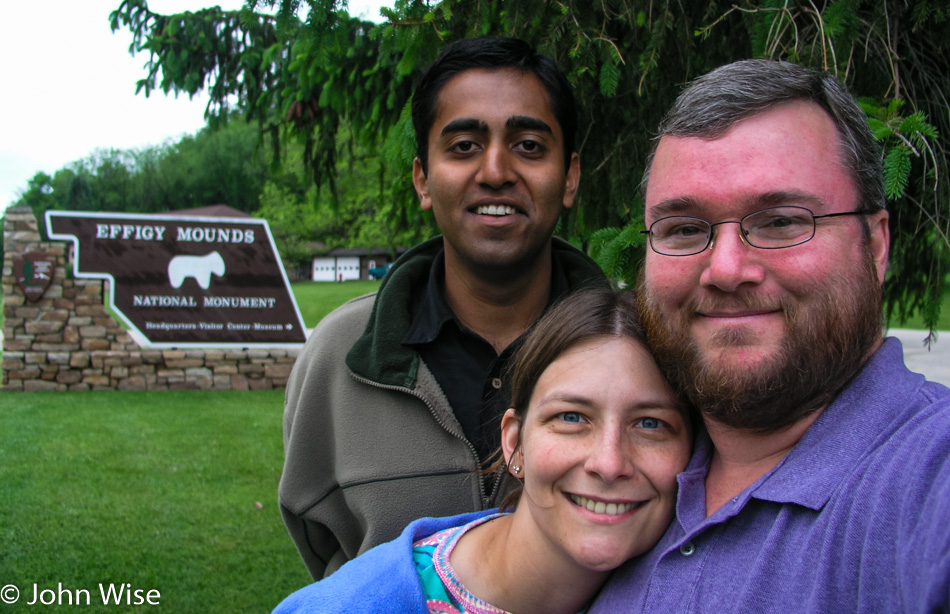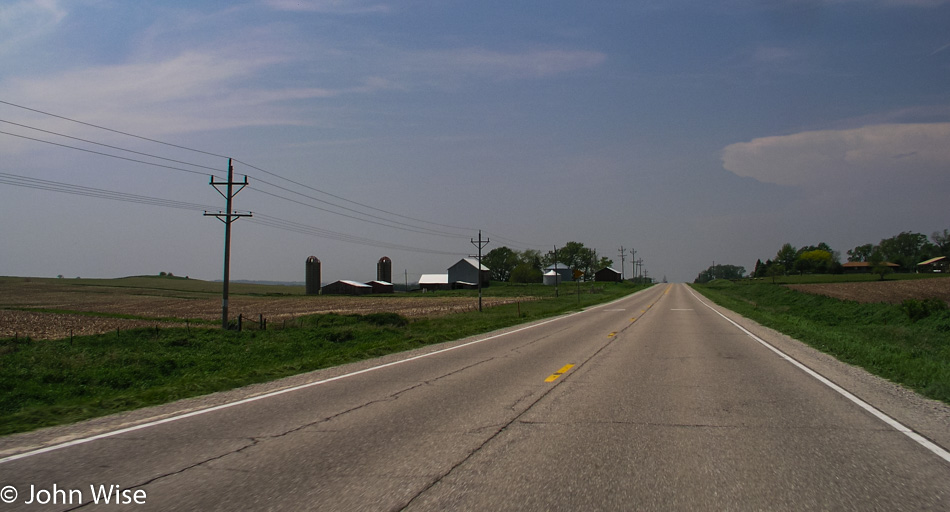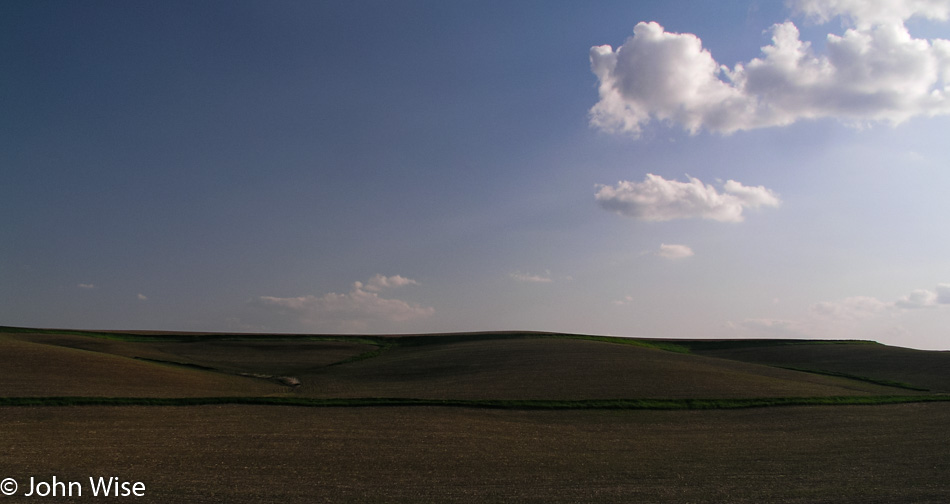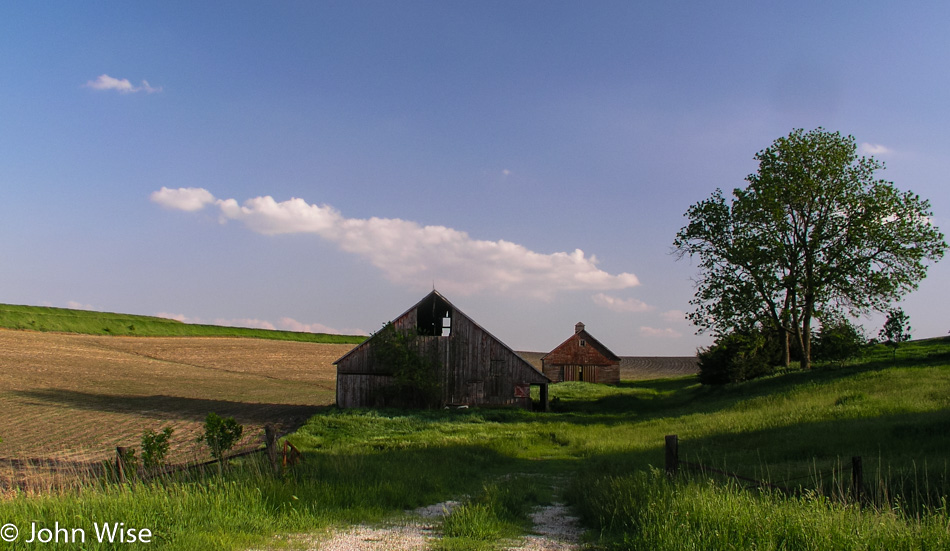
It was bound to happen: bad weather is collecting overhead. Thunder, lightning, and rain, with the TV news issuing flood warnings north of us. Some mild disappointment makes an appearance with the realization that the Apple Blossom Scenic Drive won’t be quite as scenic under these conditions. But we are heading generally southeast away from the storms so our hopes are that we might drive out of the foul weather and back into blue skies.
An hour down the road and a break in the clouds offer hope for a brighter future on the horizon. At Prairie du Chien we stop for a hot breakfast, the first since the Teton’s nearly a week ago. Our restaurant of choice is McDonald’s, hot and greasy. We ordered a bunch of Egg McMuffins, hash browns, coffee, and orange juice. After so many days of eating cold food from our ice chest, McDonald’s has extraordinary appeal.

Wisconsin begins to fade away as Iowa comes into view after crossing the Mississippi for the last time during this vacation. From Marquette, the road north along the western shore of the Mississippi will take us to Effigy Mounds National Monument.

Amazing, it is as though someone switched on super green. We entered the park near the visitor’s center after one of the park personnel familiarized us with the lay of the land. The trail begins easily enough on a boardwalk leading us to the base of the mountain we are about to climb, not a giant Western-style mountain, mind you. The dirt trail that’s up next isn’t all that steep initially, but after the first bend, we start making a fairly steep ascent. Steep enough to require a number of switchbacks, but any difficulty the trail gives is more than made up for with the lush flora surrounding our every step.

Flowers abound, tiny and delicate, a kind of whisper of beauty in the woods. Ferns, mosses, mushrooms, snails, and new plant growth of all types are found in every direction.

We are tiptoeing through an enchanted forest with a quiet typically reserved for libraries. The beauty is so great we don’t want the slightest noise from our plodding steps to disturb the scenery. In hushed tones, Jay draws my attention to another strange-looking fungus, and then we see our first effigy. It’s a bear. Next to the bear is a string of mounds our guidebook suggests are likely burial mounds and are not effigies themselves.

I almost overdosed on this encounter with Green. There should be warnings here for people coming out of the Southwest that saturation could have deleterious effects on people more accustomed to a brown palette with hints of tan.

Along the emerald green path, I’m still picking out small mushrooms, little flowers, and a field of plants, creating a floor sitting a foot and a half off the ground. The Great Bear Mound is the largest effigy remaining in the park system; it is so large I can find no way to photograph it to demonstrate its bear likeness.

Fungi of assorted types are scattered about here in greater frequency than we’ve seen elsewhere in America. A wide variety and odd shapes peak out or grow on various surfaces almost everywhere we look. Bulbous knoblike mushrooms and white giant ones with spiders making homes within semi-transparent louvered cozy-looking fins found underneath. Then, right next door are blobs of melted wax-looking fungi that are scattered about.

At the top of our short hike is Fire Point, a lookout over the Mississippi River. Hey, was that the sun? Get real.

Back on the other side of the small town of Marquette is a boat launch, another one of “those” photos, you know, standing in the water. Without speed boats, crowds, police helicopters, and other distractions, the river looks to us the way it must have looked to the Native Americans and early white settlers a couple of centuries ago. We are sad to leave the great Mississippi River.

Before we’d ever visited the Great Plains, I’d heard about the vast wheat and cornfields that stretch across the expanse of flat land called the heartland of America. Images of verdant rolling hills with an abundance of rivers, sporadic trees, wildflowers, prairies, and meadows were never a part of that equation. Today’s trip to Iowa is an eye-opener. The only time we hear of Iowa in the western United States is when the annual tornado tears out another trailer park. During our brief time in Iowa, we never see even one mobile home park but we see a ton of lush beauty.
The homes we do see are immaculate. We had noticed a phenomenon while in Wisconsin that has roots in Iowa, too; maybe it’s a Midwest characteristic. Their yards have the cleanest, most well-groomed lawns the three of us have ever laid eyes on. The nation’s golf course manicurists must all hail from the Midwest. In the middle of the afternoon, you can see maybe one in four homeowners out behind the lawnmower but more probably riding the lawnmower.
Entering the small village of Vinton, we drive into classic Americana. This is the place I would like to call home. Main Street is wide, with broad sidewalks and storefronts sitting below the two-story buildings that line the street. Garish neon signs are not seen, and the street lamps are old-fashioned globes that leave a nicer impression than a glowing Budweiser sign. The town is clean and quiet, seemingly in better financial shape than larger cities like Superior in Wisconsin. I wish the town officials luck in maintaining the character of such a fine little place.

South of Vinton, we are entering the Amana Colonies and right away wish we had more time to stroll the streets and historic buildings on this gorgeous spring day. We pass through West Amana for the main Amana Colony. You step out of the car and into a view of America not seen for one hundred years. The village is superbly maintained, its German heritage fully intact.
If for no other reason than the historic appeal of each and every building, even non-shoppers such as myself must be drawn into the stores. Stepping out of the bakery, we notice that the humidity is rising rapidly, quite high, really. To the north from where we have come from, dark clouds are amassing. A shop owner tells us what radio station to tune into when we return to the car so we can hear any weather alerts if they are issued.

We continue our walk amongst the historic buildings stopping occasionally on the lookout for gifts for friends and family back in Phoenix. Caroline and Jay both find candles for themselves, and I pick up two pounds of caramels to split between three or four friends. The old German architecture is complemented by well-tended gardens. Houses are made of stone, brick, and bare wood planks. Gardens are a combination of a wide variety of shrubs and a terrific assortment of the most colorful flowers.
The humidity is bearing down, and thunder is heard in the distance. With a bit of rain starting to fall, we leave the Amana Colonies and look back once we are on the road to see a blackening sky and remember the radio station. 105.7 KOKZ comes in with the announcer telling of tornado warnings in effect for three counties northeast of Amana or the area we just drove through.

In order to put distance between us and any tornado, we turn onto Interstate 80 heading west. For more than 100 miles, we cruise along at 80 mph, looking at blue skies, happy to miss a tornado but unhappy to have missed the intimacy of the countryside drive. Exit 93 at Stuart will take us back to the smaller road we should have stayed on had it not been for the storms.

Just 10 minutes after leaving the Interstate with the hope of making a solid disconnect with the speed of the highway, I turn off at Nations Bridge Park, following a small dirt road to a hilltop. On said hilltop sits a two-story viewing platform that only looks in one direction and that is through a heavy mesh fence that stops people from crawling out on the roof of the building. Not exactly memorable, but nice.

Another river, another house, more rolling hills, a windblown field of grass, the sun drawing lower in the sky. A large farm, a solitary tree, two barns on the side of a hill, the sun now hiding behind a cloud. The pace is slow and the road long; not a lot to distract the senses of someone needing constant stimulation, but this is just fine for me today.
Entering Kimballton an odd sight of Hans Christian Andersen’s Little Mermaid perched on a dry fountain. At 6:15 p.m., the town is closed for the evening, and short of rolling up the sidewalks, this place is empty. The same goes for Elk Horn, where we’ve come to see a famous Danish windmill, everything is closed.
The windmill came to America in early 1976 to help us celebrate our Bicentennial and possibly help maintain a small town, a town with one of the largest populations of Danes, too. Built-in 1848 in Norre Snede, Denmark, the windmill was disassembled and shipped to America. With the help of 300 volunteers, the iconic attraction was reassembled to become the only authentic Danish-built windmill in America.

Heading west as our destination is still way out in the distance.

It’s toward the end of sunset when we reach the Nebraska State Line and then speed over the bridge to dip feet into the Missouri River.

Now in Nebraska, Caroline and Jay are knee-deep in the Missouri River. This has been a great day for stepping into iconic waterways. After only 15 minutes in Nebraska, we are back in Iowa as that’s just the way the road works out this way.

With daylight fading and night fast approaching, we enter the De Soto National Wildlife Refuge to watch the rest of the sun slip under the horizon. The darkening blue sky hanging over this channel of the Missouri River flows past the border of tall grass meadows framed by forest. A small lake is half encircled with cattails, and a pond reflects some of the last light in front of silhouetted trees. At the shore of the Missouri is a high cloud, grabbing hold of the remaining light; the sun will scatter over the river, reflecting golden light in the waters before us. Our day becomes complete with this grand show between water, sky, and sun.
At 9:00 p.m., we finally leave the refuge and head into Council Bluffs, Iowa to hunt for pizza. The best and only thing we can find is Godfathers. Forty-five minutes later, we are on Interstate 29, south of Rockport, Missouri. With some minor difficulty in such a small town, we finally found our hotel. The hotel isn’t really in Rockport; it is the next exit after the turn-off for Rockport. It’s 11:30 p.m. as we lay down.